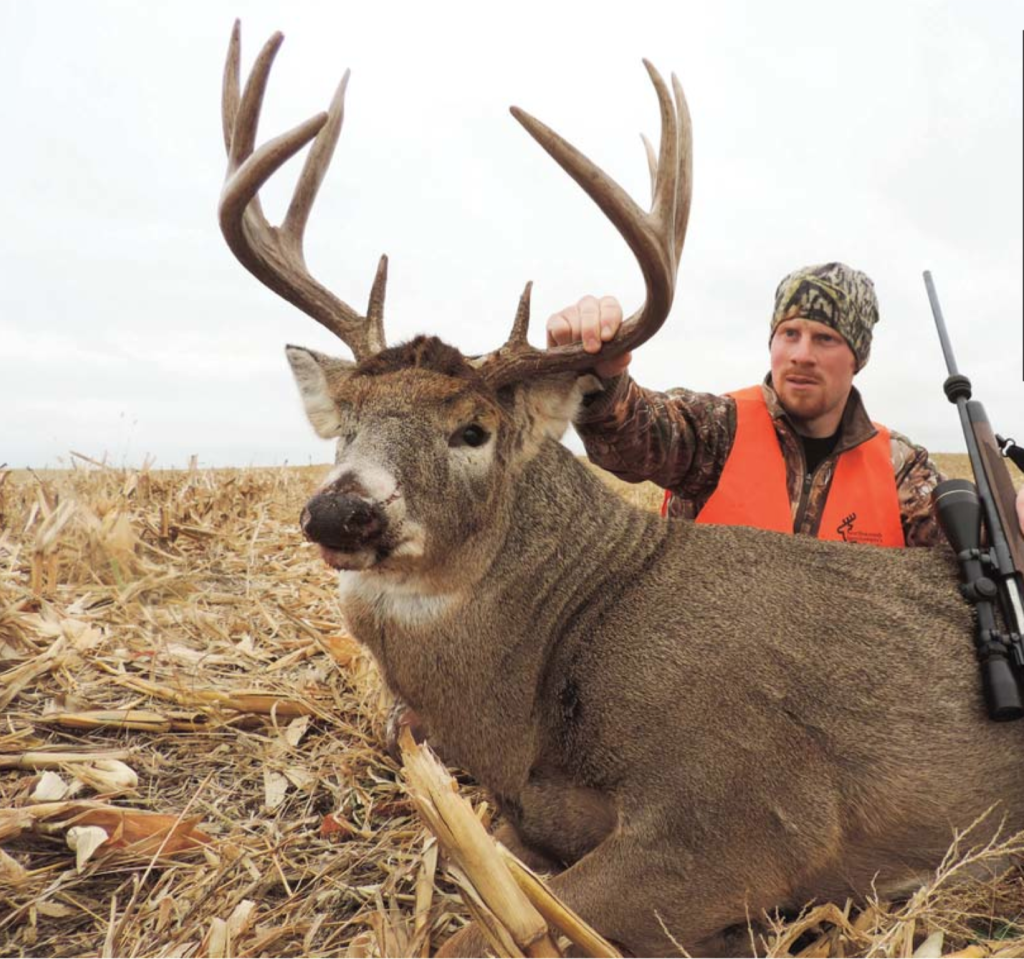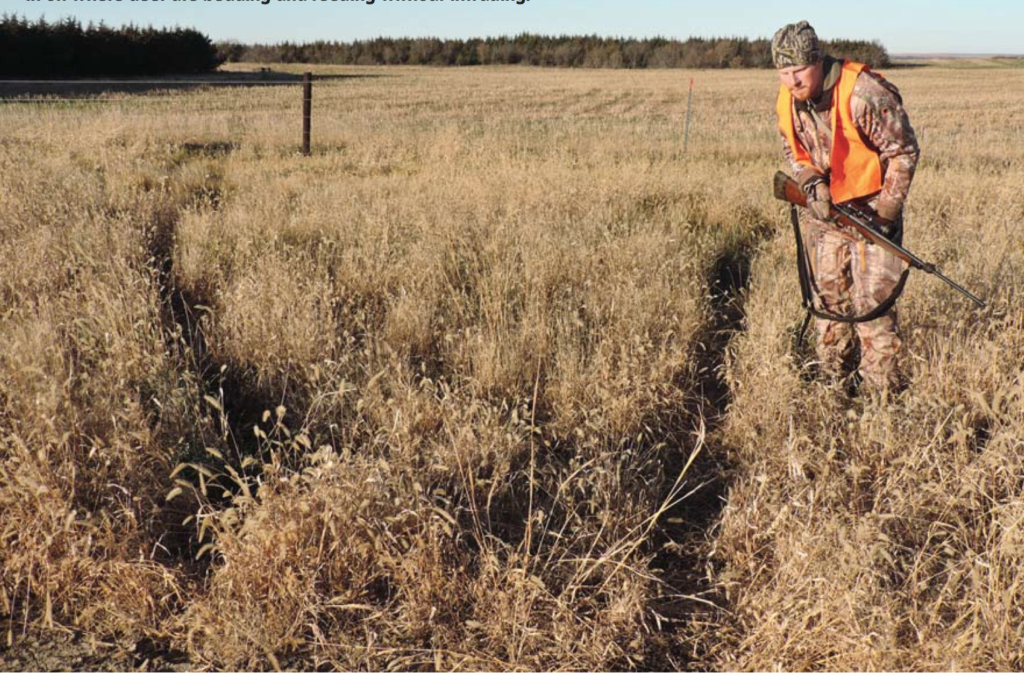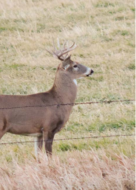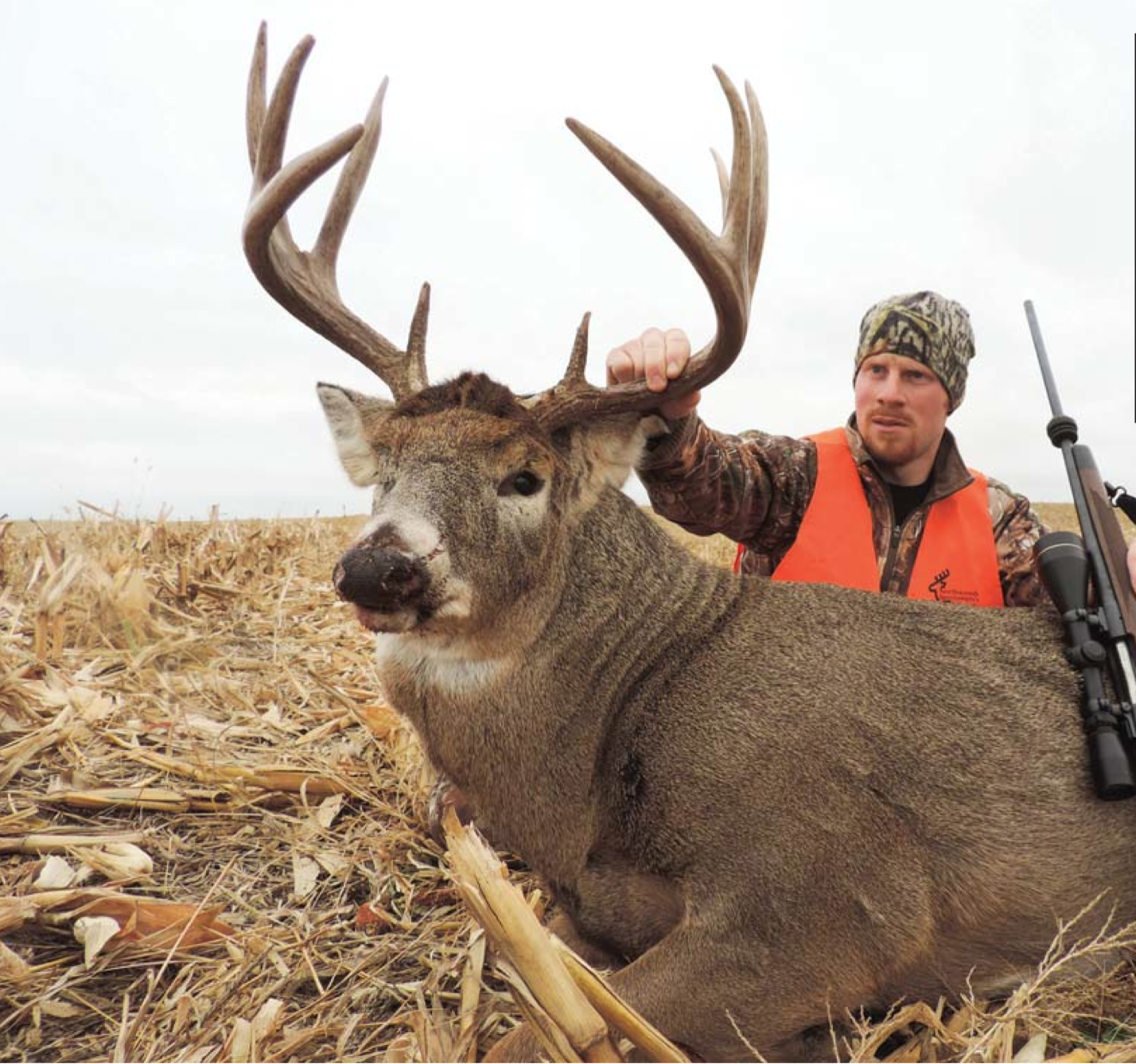

If you scout, do your homework and are patient you may be rewarded with an open country Plains buck. The author killed his best rifle buck with some basic legwork, meeting landowners from bowhunting trips and then going out with a goal in mind. (Photo: Darron McDougal)
If you’re looking for a diamond in the rough, sometimes it pays to scout and hunt unlikely areas. Here’s how rifle hunters can pluck monster bucks from unsightly, overlooked real estate.
Most folks think of lush fields and hardwood forest when whitetail hunting is discussed, so it’s no surprise that hunters annually drive right by prime opportunities as they search for greener pastures. I’ve done this myself. Badlands, wide-open plains or vertical river breaks pocked with impenetrable plum brush don’t scream whitetail to the uneducated. But the fact is, these can be some of the most productive places to hunt some of the nation’s largest bucks.
I vividly recall my first trip to hunt public lands in Kansas as a teenager. My brother had previously taken several outstanding bucks there, and when I showed up as the new kid on the block, I couldn’t believe it harbored whitetails. Trees were nearly nonexistent, but I soon learned that is actually beneficial for choosing stand locations. I quickly became a believer in hunting desolate or otherwise unusual topography, largely because most hunters overlook it.
Before you drive by what looks like the lowliest of low whitetail habitat, let’s discuss why it could produce your largest buck to date.
1. You’re not the only one driving by: The deserted, desolate, forsaken ground I’ve been referring to is exactly what helps whitetails reach maturity. People constantly overlook it, and in most cases, it’s well off the beaten path where human populations are outnumbered by deer. Thus, it simply doesn’t receive the hunting pressure of more inviting properties conveniently located closer to the city. That alone makes it a great place to hunt.
2. Few people know how to hunt it: Those who’ve exclusively hunted timbered whitetail habitat know little to nothing about how to hunt plains or rugged river breaks. I know because I used to struggle with choosing stand locations myself.
Like any whitetail habitat, preliminary map work will help you deploy a wise approach. Study satellite imagery to determine the property’s terrain features. I usually seek parcels with a water source, preferably a creek or river. Whitetails naturally travel these corridors, especially during the rut. The key is to locate terrain features that create funnels or pinch points. River crossings are another hot bet. Focus on terrain more than deer sign.
While looking over aerial images, study outlying areas for possible food sources and bedding areas. If you’re working with a somewhat small public parcel, odds are good that deer are neither bedding nor feeding on it, but instead are using it solely for travel between necessities. Some people are discouraged by this, but it’s actually a good thing for accessing stands without bumping deer.
3. Bucks grow old: Another reason haggard-looking country is great for hunting is because deer can walk circles around ignorant hunters. This is so often the case, especially in broken country with thick brush. My brother, who lives in South Dakota, witnesses this annually while hunting public lands. He often sees other hunters walking along wide-open ridge tops or haphazardly busting through thick brush. Often, the deer are long gone by the time the hunters get there, or they simply walk circles around them, even bedding in the same spot where they were originally bumped once the hunters have passed. They spend their entire lives in this country, and their aptitude to skirt hunters gets many bucks a free pass. Consequently, the age class tends to be pretty decent. And we all know that if you’re going to shoot mature bucks, they must exist in your hunting area.
WATCH: Great Binoculars Help You Scout and Find More Deer
4. Licenses are generally easy to obtain: Most states that feature the sort of terrain we’re discussing offer easy-to-draw whitetail tags, especially for bowhunters. Firearm tags usually aren’t too difficult to obtain either.
Jump online to determine if tags are available over the counter, or if they must be applied for and drawn. Look into Kansas, Nebraska, Wyoming, Montana, Oklahoma, Nebraska, North Dakota and South Dakota. These states represent the terrain and topography we’re discussing, and they annually produce barn-burner bucks. Plus, they’re fun places to explore with a firearm in your hands.
5. Bucks are more visible during daylight: Again, desolate whitetail locations generally receive little hunting pressure. This means that if you arrive early and hunt wisely, you’ll most likely see deer and possibly some good to great bucks. Mature bucks sense pressure influxes, which is why deer in more populated states often display nocturnal tendencies. For the most part, deer in the states I noted earlier tend to move during daylight more often than their Eastern cousins.
Further, the visibility and openness of the plains states helps you cover more ground from one location. Plus, if you’re a crack shot, you can cover a great deal of it from that one location. I strongly recommend an elevated observation setup for the first day or two of your hunt. This low-impact approach is more effective than tromping around on foot. Let your binos be your friend, and you’ll be way ahead of the game.
6. Public lands are plentiful: This varies by state, but most of the states I mentioned earlier have more than enough public lands to keep you busy. During early archery season, you’ll most likely see few, if any, other hunters. Of course, the rut often brings more hunters. Firearms season also might bring orange crowds into the equation, but nowhere near what you’ll witness in the East.

IF you score private land access look for trails in corn or alfalfa near thick stuff. Deer use these thicker areas for bedding and travel, and you may be able to zero in on trails that offer great vantage points for hunting. (Photo: Darron McDougal)
If you can score hunting permission on private ground in desolate or rugged country, focus on alfalfa fields or cornfields that border the thick stuff. Worn trails like these can clue you in on where deer are bedding and feeding without intruding.
Even if opening day brings sudden pressure to your chosen location, evading the pressure usually just means hiking deeper. Many Western deer hunters don’t invest the time and dedication to hunt hardcore, though there are exceptions. Few walk a mile or more from the parking area. So, if you have enough land at your disposal, hike deep to find solitude from the multitudes.
While we’re discussing public lands, contact your chosen state’s game department to learn what lands are open for hunting. Walk-In Areas, Game Production Areas and Wildlife Management Areas all are obvious choices, but other hunting opportunities might exist that are less publicized. For example, some state game departments work with landowners who want deer harvested, but who don’t want their land open to everyone. This is a way for them to selectively allow access, usually for a small trespass fee or even for free.
MY DIAMOND IN THE ROUGH
Honestly, I’m a bowhunter by upbringing. I suppose that can be attributed to the orange parade that ensues every gun season in my home state of Wisconsin, which doesn’t appeal to me at all. And while I’ve bowhunted every state mentioned above, except for Montana, I knew it was time to try rifle hunting in some of these desolate places.
With one preference point, I pulled a firearms whitetail permit in South Dakota. I’d previously bowhunted public lands in the area, and eventually became friends with a cattle rancher in the unit for which my permit was valid. He granted me hunting access. His ground is covered up in mule deer, but there are decent whitetail numbers, too.

Deer like this are a dime a dozen in the Plains states. Be patient and don’t shoot the first bucks you see if you’re determined to kill something bigger. (Photo: Darron McDougal)
On Nov. 15, my wife Becca and I drove into the property at daybreak to glass fields as deer were finishing up feeding and leaving the fields to go to their river-break bedding areas. We saw tons of deer, but most were muleys. We continued bouncing around in our 1-ton when we spotted some white-tailed does and a decent 120-class 10-pointer. I believed I could do better, even if I had to resort to the public lands.
With the rut in full swing, we parked the pick-up, loaded my .30-06, and went for a walk to glass the breaks. We soon saw a nice 130-class 8-pointer. He was running like a bird dog with his nose to the ground. But he was too far away for a shot, and I wasn’t ready to settle just yet.
About five minutes later, I peeked over a hill in a corn-stubble field and saw a mid-130-class 8-pointer with heavy beams. I was contemplating when my eyes caught movement at the field edge 400 yards away. It was the buck I’d come to South Dakota for. His frame had “150” written all over it. But he was farther than I felt comfortable shooting. He chased a doe off the field and into the breaks.
After discussing what had happened with Becca, who’d been unable to see everything, we elected to come back to the field that afternoon rather than try to relocate the buck in the breaks. It was only the first morning, and I felt tromping around would do more harm than good.
We arrived back at the field around 2:30 p.m. and situated ourselves atop some round bales overlooking the field. I certainly couldn’t cover the entire field with my rifle, but I could cover the areas the whitetails had seemed to favor that morning. We watched mule deer after mule deer visit the field that afternoon. In fact, we counted 44 of them.
As dusk hinted its arrival, whitetails began popping out. First it was does, then it was young bucks. Dark- ness was fast approaching, and the big boy just wasn’t showing. With maybe two minutes of legal light left, I saw a deer with a stud body enter the field.
“That’s my guy,” I whispered to Becca.
He was walking steadily toward a group of does, and I wasn’t going to rush the 175-yard shot. He finally stopped broadside at 205 yards, and with my rock-solid haybale rest, it was a no-brainer. I lined up the crosshairs on the front of his shoulder to account for the 20-mph crosswind, then squeezed the trigger. The buck reared, ran 30 yards and dumped over in a heap. At 150 inches, the deer is my best firearms buck.
I’ve bought about 13 Wisconsin gun licenses over the years, and I’ve never seen a buck that would even compare to this one. My first rifle hunt in some of America’s most rugged whitetail country yielded a bruiser. I can promise you that I’ll be back as soon as I draw another tag.
I know you’re probably thinking that I only succeeded because I was on private ground. Well, that’s not necessarily the case. My brother, who lives near where I was hunting, has taken some impressive deer on public lands that are even nastier and thicker than the breaks I was hunting near. And, gaining permission to hunt private ground is an accomplishment itself these days, although Western folks seem to be more willing if you’re nice and offer them something in return.
CONCLUSION
Many hunters overlook rough terrain or wide-open prairies. This is an uneducated decision. Believe me, they’re missing some of America’s finest deer-hunting opportunities. I’ve bowhunted these places extensively, and I plan to rifle hunt them more often in coming years as more opportunities present themselves.
I urge you to give it a go. At first, you’ll ask the question, “Are there really whitetails out there?” After tapping into it, you’ll no longer ask that question. In fact, I’ve seen astound- ing deer numbers in locations where I once stood and asked that question, particularly in Nebraska and North Dakota. If I hadn’t dove in, I’d be missing outstanding deer-hunting opportunities like so many other deer hunters.
Don’t be that person. Go find your diamond in the rough!
— Darron McDougal is a driven white-tailed deer hunter and full-time freelance outdoor writer from Antigo, Wisconsin. He annually hunts white-tailed deer across multiple states, primarily on public lands.

